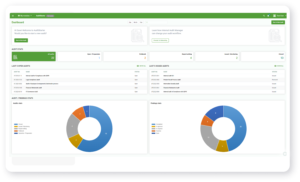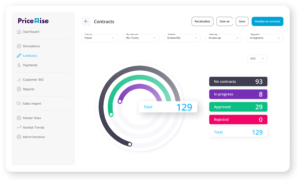Has your company jumped on the AI bandwagon yet, or are you just about to? With language models, GenAI, AI agents, and other advancements seeping into business domains one by one, the question of joining the hype is no longer an “if” but a “when.” According to McKinsey, “over the next three years, 92 percent of companies plan to increase their AI investments.” But while nearly all organizations proclaim their readiness to invest in AI, the same report tempers those declarations, stating that only 1 percent of leaders call their companies “mature” on the deployment spectrum. And only in those mature organizations can AI be fully integrated into workflows and drive substantial business outcomes.
But what about the many firms that don’t fall into this group, yet still fear falling behind? What happens when they succumb to the growing pressure to do something with AI, and do it now? C&F’s white paper on building valuable AI use cases finds that “too many organizations jump into AI with isolated pilots, unclear value, and no strategic path forward.” Rushing won’t lead to success. For any AI initiative, accurately assessing your readiness is the first step toward building an AI adoption strategy that aligns with your goals.
What AI-Ready Truly Means
Building with AI isn’t the same as adopting any other technology. While many leaders think success is just a matter of choosing the right tools or vendors, the reality is more complex. AI/machine learning initiatives succeed when they start with clarity about what problem you’re solving, what data you have, and who will own the outcome.
Organizations that skip this foundational work often find themselves stuck in endless pilots that never scale or produce measurable value. In some cases, teams move straight into development, only to discover that their data is incomplete or biased. In others, projects stall because there’s no agreement on what success should look like, or because no one has been assigned true accountability. And even when the technology itself is solid, solutions often go unused because no one has clarified why they matter to the people expected to adopt them.
Being ready doesn’t just mean having enthusiasm or a budget. It means having the discipline to ask hard questions and the patience to align stakeholders before any code is written. Readiness is the first test of whether your organization has the maturity to turn AI from an experiment into a strategic advantage, and if you can make the most of an AI framework once you adopt it.
Five Readiness Questions for a Confident AI Adoption Strategy
- What business problem are we solving?
Straightforward as it may seem, answering this question requires identifying key pain points, challenges, and opportunities within the organization. Understanding these critical business drivers is essential to mapping areas where AI may offer a viable and valuable solution. Eliminating vagueness from the start is the only way to avoid building solutions in search of a problem. Without clear alignment on what you’re solving, even the best technology will fail to deliver meaningful results.
- Do we have access to the right data?
Data is the backbone of any AI initiative, but having data isn’t the same as having the right data in the right condition. Before you commit resources, you need to know whether your data is accessible, complete, high-quality, and compliant with privacy regulations. Many projects fail because teams assume data readiness without verifying it upfront. Our white paper, The BIG AI Framework, includes a feasibility checklist you can use to evaluate whether your data is truly prepared for AI development.
- Who owns the outcome, and are they involved from the start?
A lack of clear ownership can call a halt to even the most promising AI projects. From the very beginning, it’s necessary to define who is responsible for driving the initiative forward, making key decisions, and resolving issues as they arise. Importantly, this isn’t just limited to technical leadership. Business stakeholders need to be involved early to ensure alignment with strategic priorities and to build support across the organization. When ownership is fuzzy, so is accountability, and projects simply lose momentum.
- How will we measure success?
In other words, how will you know if your AI project is delivering real value? By establishing a shared definition of success from the start. Teams should agree on quantitative metrics, such as time savings, accuracy improvements, and cost reductions, as well as qualitative ones, e.g., better customer experience or increased employee engagement. With measures clearly defined, you will also be able to refine your approach over time. The BIG AI Framework includes examples of value estimation methods you can adapt to define success criteria before development begins.
- Are we prioritizing this effort or just experimenting?
AI projects can be resource-intensive, and not every idea is worth pursuing. Before you start, it’s critical to look at your broader portfolio of initiatives and decide where this effort fits. Is it a strategic priority with clear backing, or an experiment driven by fear of missing out? When priorities aren’t explicit, teams risk spreading themselves too thin and diluting impact. Being honest about where your project sits on the roadmap is essential to focus resources where they matter most.
Common Pitfalls of Skipping an AI Adoption Framework
Once you’ve reflected on these questions, the next challenge is how to put your insights into practice. Many organizations underestimate how quickly AI initiatives can go off track. Even with the best intentions, teams that rush to build often discover too late that they skipped essential steps. One common pitfall is treating AI as just another IT project instead of recognizing that success depends on clear business alignment, data readiness, and shared accountability.
Another frequent mistake is assuming that small pilots will naturally scale into enterprise solutions without an AI implementation plan or a clear framework to guide execution. In reality, pilots launched without an adoption framework often stall out or create technical debt that becomes costly to unwind. Finally, some companies try to tackle too many priorities at once, spreading resources thin across disconnected experiments rather than focusing on the few efforts most likely to deliver measurable outcomes.
Avoiding these pitfalls requires discipline and a structured approach. A proven AI adoption framework can help you set clear priorities, define ownership, and create the conditions for sustainable success.
Building a Framework for Your AI Adoption Strategy
The pressure to act on AI is only growing, and for many organizations, the temptation to jump in without a plan can be hard to resist. But as the most mature companies have shown, sustainable impact doesn’t come from isolated experiments or reactive investments. It comes from approaching AI as a strategic capability that requires clear priorities, disciplined execution, and a framework to guide decisions along the way.
Before you commit time and resources, take a step back to evaluate your readiness and align your goals. When you build on a solid foundation, you’ll be far better prepared to scale what works, avoid costly missteps, and turn AI from a buzzword into lasting business value.
If you’re ready to go deeper, The BIG AI Framework white paper offers a proven structure to help you define priorities, build consensus, and turn your AI adoption strategy into real business outcomes.
Would you like more information about this topic?
Complete the form below.

